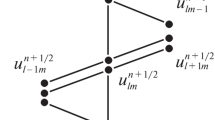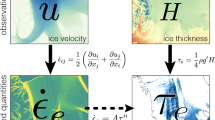Abstract
The different approaches explored by the authors to model the visco-plastic anisotropic behaviour of polar ice associated with the formation and evolution of fabrics, are reviewed. In order to achieve ice rheological models which can significantly improve the simulations of the evolution of ice sheets under varying climatic conditions, these models aim at taking into account the physical mechanisms likely to be active under the conditions prevailing in an ice sheet. Since the destination of a constitutive model for polar ice is its implementation into a large scale ice-sheet model, which is to be run extensively to simulate various climatic scenarios, some compromises must be made to limit its complexity. A possible solution is to use a hierarchy of models of increasing complexity. In this respect the results from the different models are compared and discussed from the viewpoint of ice-sheet flow modelling.
Access this chapter
Tax calculation will be finalised at checkout
Purchases are for personal use only
Preview
Unable to display preview. Download preview PDF.
Similar content being viewed by others
References
Ahmad, S. and Whitworth, R. W. 1988. Dislocation motion in ice: A study by synchrotron X-ray topography. Phil Mag., 57, 749–766.
Alley, R. B., Perepezko, J. H. and Bentley, C. R. 1986. Grain growth in polar ice: II. Application. J. Glaciol., 32, 425–433.
Alley, R. B. 1992. Flow-law hypotheses for ice-sheet modeling. J. Glaciol., 38, 245–256.
Alley, R. B. and Woods, G. A. 1996. Impurity influence on normal grain growth in the GISP2 ice core, Greenland. J. Glaciol., 42, 255–260.
Azuma, N. and Higashi, A. 1985. Formation processes of ice fabric pattern in ice sheets. Ann. Glaciol., 6, 130–134.
Azuma, N. 1994. A flow law for anisotropic ice and its application to ice sheets. Earth Planet Sci. Lett, 128(3–4), 601–614.
Boehler, J. P. 1975. Contributions théoriques et expérimentales à l’étude des milieux plastiques anisotropes. Thèse de Doctorat d’Etat es Sciences, Université Scientifique et Médicale de Grenoble, 133 pp.
Bouchez, J. L. and Duval, P. 1982. The fabric of polycrystalline ice deformed in simple shear: experiments in torsion, natural deformation and geometrical interpretation. Text. Microstruc, 5, 171–190.
Castelnau, O. 1996. Modélisation du comportement mécanique de la glace poly-cristalline par une approche auto-cohérente: application au développement de textures dans les glaces des calottes polaires. Thèse de Doctorat de l’Université Joseph Fourier-Grenoble I, 198 pp.
Castelnau, O., Duval, P., Lebensohn, R. A. and Canova, G. R. 1996a. Viscoplastic modeling of texture development in polyeryst alline ice with a self-consistent approach : Comparison with bound estimates. J. Geophys. Res., 101(6), 13851–13868.
Castelnau, O., Thorsteinsson, Th., Kipfstuhl, J., Duval, P. and Canova, G.R. 1996b. Modelling fabric development along the GRIP ice core (central Greenland), Ann. Glaciol, 23, 194–201.
Castelnau, O., Canova, G. R., Lebensohn, R. A. and Duval, P. 1997. Modelling viscoplastic behavior of anisotropic polycrystalline ice with a self-consistent approach. Acta Mater., 45(11), 4823–4834.
Castelnau, O., Shoji, H., Mangeney, A., Milsch, H., Duval, P., Miyamoto, A., Kawada, K. and Watanabe, O. 1998. Anisotropic behavior of GRIP ices and flow in Central Greenland. Earth and Plan. Sc. Letters, 154, 307–322.
Dahl-Jensen, D. and Gundestrup, N. S. 1987. Constitutive properties of ice at Dye 3, Greenland. In International Association of Hydrological Sciences, Publication 170. 31–43, (Symposium on The Physical Basis of Ice Sheet Modelling, 9–22 August 1987, Vancouver).
Dahl-Jensen, D., Johnsen, S. J., Hammer, C. U., Clausen, H. B. and Jouzel, J. 1993, Past accumulation rates derived from observed annual layers in the GRIP ice core from Summit, central Greenland. NATO ASI Ser., Ser. I, 12, 517–531.
De La Chapelle, S., Castelnau, O., Lipenkov, V. and Duval P. 1998. Dynamic recrystallization and texture development in ice as revealed by the study of deep ice cores in Antatctica and Greenland. J. Geoph. Res., 103 (B3), 5091–5105.
Doake, C. S. M. and Wolff, E. W. 1985. Flow law for ice in polar ice sheets. Nature, 314, 255–257.
Duval, P., Ashby, M. F. and Andermann, I. 1983. Rate-controlling processes in the creep of polycrystalline ice. J. Phys. Chem., bf 87(21), 4066–4074.
Duval, P. and Castelnau, O. 1995. Dynamic recrystallization of ice in polar ice sheets. J. Phys. C3, 5, 197–205.
Eshelby, J. D. (1957) The determination of the elastic field of an ellipsoidal inclusion, and related problems. Proc. Roy. Soc. A, 241, 376–396.
Fujita, S., Nakawo, M. and Mae, S. 1987. Orientation of the 700-m Mizuho core and its strain history. Proceedings of the NIPR Symposium on Polar Meteorology and Glaciology, 1, 122–131 (9th NIPR Symposium, 1986).
Gagliardini, O. 1999, Simulation numérique d’un écoulement bidimensionnel de glace polaire présentant une anisotropic induite évolutive. Thèse de Doctorat de l’Université Joseph Fourier-Grenoble I, 184 pp.
Gagliardini, O. and Meyssonnier, J. 1999a. Analytical derivations for the behavior and fabric evolution of a linear orthotropic ice polycrystal. J. Geophys. Res., 104(B8), 17,797–17,809.
Gagliardini, O. and Meyssonnier, J. 1999b. Plane flow of an ice-sheet exhibiting strain-induced anisotropy. In K. Hutter, Y. Wang, and H. Beer eds., Advances in Cold-Region Thermal Engineering and Sciences, Technological, Environmental and Climatological Impact Berlin, etc., Springer-Verlag, (Lecture Notes in Physics 533), 171–182.
Gagliardini, O. and Meyssonnier, J. 2000. Simulation of anisotropic ice flow and fabric evolution along the GRIP-GISP2 flow line (Central Greenland). Ann. Glaciol., 30, in press.
Gilormini, P. and Vernusse, P. 1992. Eshelby tensor and inclusion problem in the incompressible transversely isotropic case. C. R. Acad. Sci. (Paris), Ser.II., 314(3), 257–261.
Gödert, G. and Hutter, K. 1998. Induced anisotropy in large ice shields: Theory and its homogenization. Continuum Mech. Thermodyn., 10, 293–318.
Goldsby, D. L. and Kohlstedt, D. L. 1997. Grain boundary sliding in fine-grained ice I. Scripta Materialia, 37(9), 1399–1406.
Goldsby, D. L. and Kohlstedt, D. L. 1998. Are glaciers and ice sheets superplastic? AGU Fall Meeting, San Francisco, F, 310–311.
Gow, A. J. and Williamson, T. C. 1976. Rheological implications of the internal structure and crystal fabrics of the West Antarctic ice sheet as revealed by deep core drilling at Byrd Station. Geol.Soc.Am.Bull., 87(12), 1665–1677.
Gundestrup, N. S. and Hansen, B. L. 1984. Bore hole survey at Dye3, South Greenland. J. Glaciol., 30(106), 282–288.
Hansen, B. L. and Gundestrup, N. S. 1988. Resurvey of bore hole at Dye3, South Greenland. J. Glaciol., 34(117), 178–182.
Herron, S. L. and Langway Jr., C. C. 1982. A comparison of ice fabrics and textures at Camp Century, Greenland and Byrd Station, Antarctica. Ann. Glaciol., 3, 118–124.
Higashi, A., Fukuda, A., Hondoh, T., Goto, K. and Amakai, S. 1985. Dynamical dislocation processes in ice crystal. Proc. Yamada Conference IX , edited by T. Susuki, K. Ninomiya, K. Sumino and S. Takeuchi, Univ. of Tokyo Press, Tokyo, 511–515.
Hondoh, T., Iwamatsu, H. and S. Mae, S. 1990. Dislocation mobility for nonbasal glide in ice measured by in situ X-ray topography. Phil. Mag., 62, 89–102.
Hutter, K. 1983. Theoretical Glaciology, D. Reidel, Dordrecht, The Netherlands.
Jacka, T. H. 1984. The time and strain required for development of minimum strain rates in ice, Cold Reg. Sci. Technol., 8, 261–268.
Jacka, T. H. and Maccagnan, M. 1984. Ice crystallographic and strain rate changes with strain in compression and extension. Cold Reg.Sci.Technol, 8(3), 269–286.
Johnson, A. F. 1982. Creep characterization of eutectic composites. Mechanical behaviour of anisotropic solids, Proceedings of the Euromech Colloquium 115, J.P. Boehler Ed., Martinus Nijhoff Publishers and Editions du CNRS, 1982, 927 pp.
Kamb, W. B. 1961. The glide direction in ice. J. Glaciol, 3 (30), 1097–1106.
Kocks, U. F., Tomé, C. N. and Wenk, H. R. 1998. Texture and Anisotropy, Preferred Orientations in Polycrystals and their Effect on Materials Properties. Cambridge University Press, 1998, 676 pp.
Lebensohn, R. A. and Tome, C. N. 1993. A self-consistent anisotropic approach for the simulation of plastic deformation and texture development of polycrystals: Application to zirconium alloys. Acta Metall. ,41, 2611–2624.
Lipenkov, V. Y., Barkov, N. I., Duval, P. and Pimienta, P. 1989. Crystalline texture of the 2083m ice core at Vostok station, Antarctica. J. Glaciol, 35(121), 392–398.
Lipenkov, V. Ya., Salamatin, A. and Duval, P. 1997. Bubbly ice densification in ice sheets: Applications. J Glaciol., 43, 145, 397–407.
Lliboutry, L. 1969. The dynamics of temperate glaciers from the detailed viewpoint. J Glaciol, 8(53), 185–205.
Lliboutry, L. 1993. Anisotropic, transversely isotropic non linear viscosity of rock ice and rheological parameters inferred by homogenization. Int. J. Plast., 9, 619–632.
Mangeney, A., Califano, F. and Hutter, K. 1997. A numerical study of anisotropic, low Reynolds number, free surface flow of ice-sheet modeling. J. Geophys. Res., 102(B10), 22749–22764.
Mansuy, P., Meyssonnier, J. and Philip, A. 1999. Modelling the ice single-crystal viscoplastic behaviour. In K. Hutter, Y. Wang, and H. Beer eds., Advances in Cold-Region Thermal Engineering and Sciences, Technological, Environmental and Cli-matological Impact. Berlin, etc., Springer-Verlag, (Lecture Notes in Physics 533), 215–224.
Mellor, M. and Testa, R. 1969. Creep of ice under low stress. J. Glaciol.., 8(52), 147–152.
Meyssonnier, J. and Philip, A. 1996. A model for the tangent viscous behaviour of anisotropic polar ice. Ann. Glaciol., 23, 253–261.
Meyssonnier, J. and Philip, A. 1999. Remarks on self-consistent modelling of poly-crystalline ice. In K. Hutter, Y. Wang, and H. Beer eds.,Advances in Cold-Region Thermal Engineering and Sciences, Technological, Environmental and Climatolo-gical Impact. Berlin, etc., Springer-Verlag, (Lecture Notes in Physics 533), 225–236.
Meyssonnier, J. and Philip, A. 2000. Comparison of Finite-Element and homogenization methods for modelling the viscoplastic behaviour of a S2-columnar ice polycrystal. Ann. Glaciol., 30, in press.
Montagnat, M. and Duval, P. 2000. Rate controlling processes in the creep of polar ice, influence of grain boundary migration associated with recrystallization. Earth Planet. Sci. Lett., in press.
Morland, L. W. and Staroszczyk, R. 1998. Viscous response of polar ice with evolving fabric. Continuum Mech. Thermodyn., 10(3), 135–152.
Philip, A. and Meyssonnier, J. 1999. Anisotropic isothermal ice-cap flow with the shallow ice approximation. In K. Hutter, Y. Wang, and H. Beer eds., Advances in Cold-Region Thermal Engineering and Sciences, Technological, Environmental and Climatological Impact. Berlin, etc., Springer-Verlag, (Lecture Notes in Physics 533), 237–248.
Pimienta, P., Duval, P. and Lipenkov, V. Y. 1987. Mechanical behavior of anisotropic polar ice. In International Association of Hydrological Sciences, Publication 170.57–66 (Symposium on The Physical Basis of Ice Sheet Modelling, 9–22 August 1987, Vancouver).
Pimienta, P. and Duval, P. 1989. Rheology of polar glacier ice. Ann. Glaciol, 12, 206.
Russell-Head, D. S. and Budd, W. F. 1979. Ice-sheet flow properties derived from bore-hole shear measurements combined with ice-core studies. J. Glaciol., 24(90), 117–130.
Shoji, H. and Langway Jr., C. C. 1984. Flow behavior of basal ice as related to modeling considerations. Ann. Glaciol., 5, 141–148.
Staroszczyk, R. and Morland, L. W. 2000. Orthotropic viscous response of polar ice. J. Eng. Mathematics, 37, 191–209.
Thorsteinsson, Th., Kipfstuhl, J., Eicken, H., Johnsen, S. J. and Fuhrer, K. 1995. Crystal size variations in Eemian-age ice from the GRIP ice core, Central Greenland. Earth Planet. Sci. Lett, 131, 381–394.
Thorsteinsson, Th., Kipfstuhl, J. and Miller, H. 1997. Texture and fabrics in the GRIP ice core. J. Geophys. Res., 102(C12), 26,583–26,599.
Van der Veen, C. J. and Whillans, I. M. 1994. Development of fabric in ice. Cold Reg. Sci. Technol., 22(2), 171–195.
Wilson, C. J. L. 1982. Fabrics in polycrystalline ice deformed experimentally at-10°C. Cold Reg. Sci. Technol., 6(2), 149–161.
Author information
Authors and Affiliations
Editor information
Editors and Affiliations
Rights and permissions
Copyright information
© 2001 Springer-Verlag Berlin Heidelberg
About this chapter
Cite this chapter
Meyssonnier, J., Duval, P., Gagliardini, O., Philip, A. (2001). Constitutive Modelling and Flow Simulation of Anisotropic Polar Ice. In: Straughan, B., Greve, R., Ehrentraut, H., Wang, Y. (eds) Continuum Mechanics and Applications in Geophysics and the Environment. Springer, Berlin, Heidelberg. https://doi.org/10.1007/978-3-662-04439-1_14
Download citation
DOI: https://doi.org/10.1007/978-3-662-04439-1_14
Publisher Name: Springer, Berlin, Heidelberg
Print ISBN: 978-3-642-07500-1
Online ISBN: 978-3-662-04439-1
eBook Packages: Springer Book Archive




